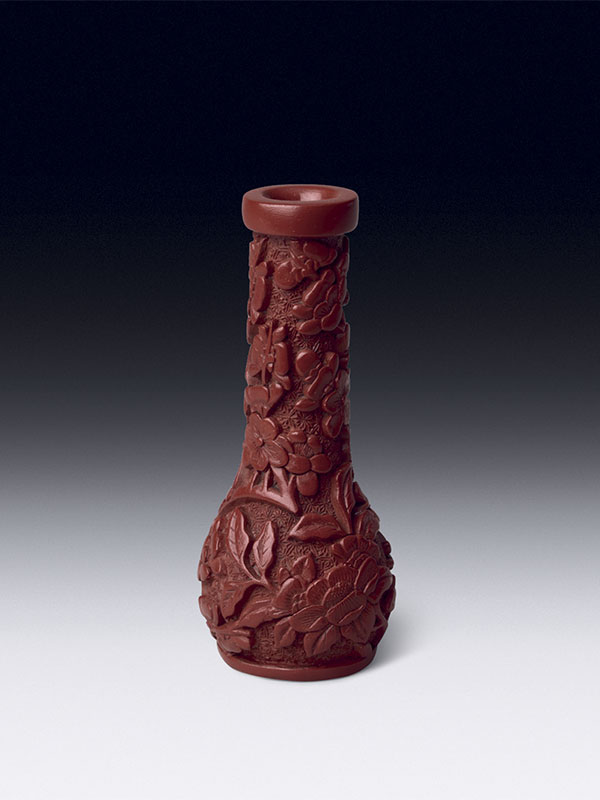Lacquer vase with plum blossoms
China, Ming dynasty, 16th century
A cinnabar lacquer vase of mallet form with bulbous body and long straight neck, terminating in a lipped rim. The body and the neck are fully carved with branches of plum blossom with buds set against a background of finely carved starburst diaper. The base is lacquered in black. The vase is contained in a Japanese wooden box.
Lacquer vases are extremely rare. It is possible that this small vase served as a holder for incense sticks. Its decoration consists of blossoms of the plum tree, which are emblematic of perseverance and purity. They also serve as a longevity symbol. Blooming on withered old branches, it is not only a welcome sight in winter but also a symbol for vigorous old age. The five petals represent the so-called Five Blessings: old age, wealth, health, love of virtue, and a natural death.[1] This design is popular on Ming lacquer pieces, and can be observed on a mid-Ming dynasty brush pot in the collection of the Palace Museum, Beijing[2] and also on two circular boxes dated to the 16th century in the collection of the National Palace Museum, Taipei.[3] A closely comparable cinnabar lacquer vase, similar in size and form, is in the Piert Borgers collection[4]
Provenance:
Private collection, Japan
Ben Janssens Oriental Art, February 2017
Private Collection, UK
1 Tse Bartholomew, T. Hidden Meanings in Chinese Art, Asian Art Museum, San Francisco, 7.48, p. 212
2 Gugong Museum: Yuan Ming Qiqi (Yuan and Ming Dynasties Lacquer)- Complete Collection of Treasures Gugong, Hong Kong/China 2006, no. 98, p. 132
3 Carving the Subtle Radiance of Colours: Treasured Lacquerware in the National Palace Museum, Taipei, 1999, nos. 43, 44, p. 64
4 Frick, P. and Borgers, W. Chinesische Lackkunst: Eine deutsche Privatsammlung, Museum für Lackkunst, Münster, no. 18, p. 48
明/剔红小香瓶
此瓶长颈,鼓腹,矮圈足,器型小巧。周身厚髹红漆,刻以锦地纹为地,其上深刻画梅花及其枝叶。构图饱满,刀工利落

